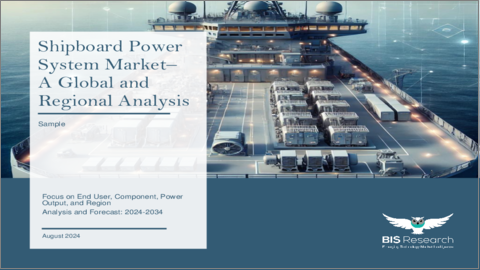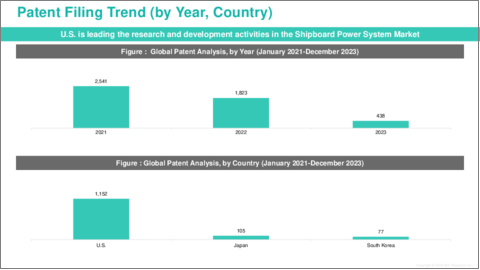|
|
市場調査レポート
商品コード
1551343
船舶用電力システム市場- 世界および地域別分析:エンドユーザー別、コンポーネント別、出力別、地域別 - 分析と予測(2024年~2034年)Shipboard Power System Market - A Global and Regional Analysis: Focus on End User, Component, Power Output, and Region - Analysis and Forecast, 2024-2034 |
||||||
カスタマイズ可能
|
|||||||
| 船舶用電力システム市場- 世界および地域別分析:エンドユーザー別、コンポーネント別、出力別、地域別 - 分析と予測(2024年~2034年) |
|
出版日: 2024年09月10日
発行: BIS Research
ページ情報: 英文 100 Pages
納期: 1~5営業日
|
全表示
- 概要
- 目次
船舶用電力システム市場は、様々な市場促進要因に後押しされ、著しい成長を遂げています。
楽観的シナリオでは、2024年の市場規模は17億8,000万米ドルと評価され、CAGR 7.33%で拡大し、2034年には36億1,000万米ドルに達すると予測されています。
船舶で電力を生産、分配、制御するためのシステムや技術は、船舶用電力システム市場に含まれます。同市場は、補助サービス、航行、推進などのさまざまな船上システムの稼働を可能にするため、海運部門にとって不可欠な存在です。温室効果ガスの排出量を削減し、エネルギー効率を高めようという世界の動きにより、最近の電力システムはより持続可能で効率的なものへと変化しています。この市場は、電力変換システム、エネルギー貯蔵システム、発電機、配電システムなど、さまざまな部品で構成されています。今後数年間で、海上業務における電化ニーズの高まりにより、船舶用電力システム市場は大幅に拡大すると予想されます。
| 主要市場統計 | |
|---|---|
| 予測期間 | 2024年~2034年 |
| 2024年の評価 | 17億8,000万米ドル |
| 2034年の予測 | 36億1,000万米ドル |
| CAGR | 7.33% |
船舶用電力システム市場は、電気推進システムやハイブリッド推進システムの利用拡大、環境規制の強化、再生可能エネルギー統合の改善など、多くの重要な要因により発展が見込まれています。温室効果ガスの排出削減を目的とした環境規制の結果、船舶用電力システムはよりクリーンで効率的なものとなっています。また、配電技術や管理技術の向上により、船舶の電力運用はより信頼性が高く効率的になっています。
アジア太平洋は、港湾インフラへの莫大な投資、力強い経済成長、海事活動により、船舶用電力システムの市場リーダーとなっています。造船業が成長し、厳しい環境法が高度な電力管理システムの使用を奨励している韓国、日本、中国がこの分野をリードしています。この分野はさらに、グリーンな海事技術に対する政府の優遇措置や補助金によって支えられており、これによって国際基準を確実に満たし、運航効率を向上させることもできます。
さらに、SDV市場を支えるには、政府のプログラムが不可欠です。米国における市場の拡大は、電気自動車や 促進要因レス自動車を支援する連邦政府や州の規制、およびスマートインフラ構想に対する大規模な資金調達に大きく依存しています。欧州連合(EU)は、厳しいCO2排出規制や、欧州グリーンディールなどの広範なスマートモビリティ政策を通じて、自動車メーカーにSDV技術を自動車に組み込むインセンティブを与えています。アジアにおける電気自動車と自律走行車セクターの支配を目指す中国政府は、V2X(Vehicle-to-Everything)接続を促進するために5Gインフラに多額の投資を行うとともに、多額の補助金と減税措置を提供しています。
当レポートでは、世界の船舶用電力システム市場について調査し、市場の概要とともに、エンドユーザー別、コンポーネント別、出力別、地域別の動向、および市場に参入する企業のプロファイルなどを提供しています。
目次
エグゼクティブサマリー
第1章 市場:業界の展望
- 動向:現在および将来の影響評価
- サプライチェーンの概要
- R&Dレビュー
- 市場情勢
- 市場力学の概要
第2章 船舶用電力システム市場(用途別)
- 用途のセグメンテーション
- 用途の概要
- 船舶用電力システム市場(エンドユーザー別)
第3章 船舶用電力システム市場(製品別)
- 製品セグメンテーション
- 製品概要
- 船舶用電力システム市場(コンポーネント別)
- 船舶用電力システム市場(出力別)
第4章 船舶用電力システム市場(地域別)
- 船舶用電力システム市場(地域別)
- 北米
- 欧州
- アジア太平洋
- その他の地域
第5章 企業プロファイル
- 今後の見通し
- 地理的評価
- 企業プロファイル
- General Electric
- Siemens
- Schneider Electric
- ABB(Hitachi)
- Eaton
- VINCI Energies
- Wartsila
- Danfoss
- Wabtec Corporation
- Cavotec SA
- Hyundai Electric and Energy Systems Co. Ltd.
- Ingeteam Corp. S.A.
- ESL Power Systems, Inc.
- Blueday Technology
- Watts Marine
- その他の主要参入企業
第6章 調査手法
Introduction to Shipboard Power System Market
The shipboard power system market is undergoing significant growth, propelled by various key factors and market drivers. In an optimistic scenario, the market is evaluated at a valuation of $1.78 billion in 2024 and is projected to expand at a CAGR of 7.33% to reach $3.61 billion by 2034.
The systems and technologies used to produce, distribute, and control electrical power on ships are included in the shipboard power systems market. This market is essential to the maritime sector since it makes a variety of on-board systems, such as auxiliary services, navigation, and propulsion, possible to operate. The worldwide movement to lower greenhouse gas emissions and boost energy efficiency has resulted in a recent change in power systems towards more sustainable and efficient ones. The market is made up of a variety of parts, including power conversion systems, energy storage systems, generators, and power distribution systems. Over the next several years, the shipboard power systems market is expected to increase significantly due to the growing need for electrification in maritime operations.
| KEY MARKET STATISTICS | |
|---|---|
| Forecast Period | 2024 - 2034 |
| 2024 Evaluation | $1.78 Billion |
| 2034 Forecast | $3.61 Billion |
| CAGR | 7.33% |
The market for shipboard power systems is expected to develop due to a number of important factors, such as the growing use of electric and hybrid propulsion systems, stricter environmental restrictions, and improvements in renewable energy integration. Ship power systems have become cleaner and more efficient as a result of environmental restrictions designed to lower greenhouse gas emissions. Improvements in power distribution and management technologies have also made shipboard power operations more dependable and efficient.
Asia Pacific is the market leader for shipboard power management systems because of its enormous investments in port infrastructure, strong economic growth, and maritime activity. Leading nations in this regard are South Korea, Japan, and China, whose shipbuilding industries are growing and whose strict environmental laws encourage the use of sophisticated power management systems. This sector is further supported by government incentives and subsidies for green maritime technologies, which also ensure that international standards are met and improve operating efficiency.
Furthermore, government programs are essential for supporting the SDV market. The expansion of the market in the United States is largely dependent on federal and state regulations that support electric and driverless vehicles as well as large financing for smart infrastructure initiatives. The European Union incentivizes car manufacturers to incorporate SDV technologies into their vehicles through its strict CO2 emission rules and extensive smart mobility policies, such the European Green Deal. Aiming to dominate the electric and autonomous car sectors in Asia, China's government is investing heavily in 5G infrastructure to facilitate vehicle-to-everything (V2X) connectivity, as well as providing large subsidies and tax breaks.
Market Segmentation:
Segmentation 1: by End User
- Commercial ships
- Military Vessels
- Underwater Vehicles
- Leisure Ships
- Small Recreational Boats
Segmentation 2: by Component
- Transformers
- Switchgear Devices
- Frequency Converters
- Cables and Accessories
- Others
Segmentation 3: by Power Output
- Up to 30 MVA
- 30-60 MVA
- Above 60 MVA
Segmentation 4: by Region
- North America
- Europe
- Asia-Pacific
- Rest-of-the-World
How can this report add value to an organization?
Product/Innovation Strategy: The global shipboard power system market has been extensively segmented based on various categories, such as end user, component, and power output. This can help readers get a clear overview of which segments account for the largest share and which ones are well-positioned to grow in the coming years.
Competitive Strategy: A detailed competitive benchmarking of the players operating in the shipboard power system market has been done to help the reader understand how players stack against each other, presenting a clear market landscape. Additionally, comprehensive competitive strategies such as partnerships, agreements, and collaborations will aid the reader in understanding the untapped revenue pockets in the market.
Key Market Players and Competition Synopsis
The companies that are profiled have been selected based on thorough secondary research, which includes analyzing company coverage, product portfolio, market penetration, and insights gathered from primary experts.
Some of the prominent companies in this market are:
- Siemens
- Schneider Electric
- ABB
- Wartsila
- Blueday Technology
Key Questions Answered in this Report:
- What are the main factors driving the demand for the shipboard power system market?
- What are the major patents filed by the companies active in the shipboard power system market?
- Who are the key players in the shipboard power system market, and what are their respective market shares?
- What partnerships or collaborations are prominent among stakeholders in the global shipboard power system market?
- What are the strategies adopted by the key companies to gain a competitive edge in the shipboard power system market?
- What is the futuristic outlook for the shipboard power system market in terms of growth potential?
- What is the current estimation of the global shipboard power system market, and what growth trajectory is projected from 2024 to 2034?
- Which application and product segment is expected to lead the market over the forecast period 2024-2034?
- Which regions demonstrate the highest adoption rates for the shipboard power system market, and what factors contribute to their leadership?
Table of Contents
Executive Summary
Scope and Definition
Market/Product Definition
Key Questions Answered
Analysis and Forecast Note
1. Markets: Industry Outlook
- 1.1 Trends: Current and Future Impact Assessment
- 1.2 Supply Chain Overview
- 1.2.1 Value Chain Analysis
- 1.3 R&D Review
- 1.3.1 Patent Filing Trend by Country, by Company
- 1.4 Overall Market Landscape
- 1.4.1 Parent Market
- 1.5 Market Dynamics Overview
- 1.5.1 Market Drivers
- 1.5.2 Market Restraints
- 1.5.3 Market Opportunities
2. Shipboard Power System Market (by Application)
- 2.1 Application Segmentation
- 2.2 Application Summary
- 2.3 Shipboard Power System Market (by End User)
- 2.3.1 Commercial ships
- 2.3.2 Military Vessels
- 2.3.3 Underwater Vehicles
- 2.3.4 Leisure Ships
- 2.3.5 Small Recreational Boats
3. Shipboard Power System Market (by Product)
- 3.1 Product Segmentation
- 3.2 Product Summary
- 3.3 Shipboard Power System Market (by Component)
- 3.3.1 Transformers
- 3.3.2 Switchgear Devices
- 3.3.3 Frequency Converters
- 3.3.4 Cables and Accessories
- 3.3.5 Others
- 3.4 Shipboard Power System Market (by Power Output)
- 3.4.1 Up to 30 MVA
- 3.4.2 30-60 MVA
- 3.4.3 Above 60 MVA
4. Shipboard Power System Market (by Region)
- 4.1 Shipboard Power System Market (by Region)
- 4.2 North America
- 4.2.1 Regional Overview
- 4.2.2 Driving Factors for Market Growth
- 4.2.3 Factors Challenging the Market
- 4.2.4 Application
- 4.2.5 Product
- 4.2.6 North America Shipboard Power System Market (by Country)
- 4.2.6.1 U.S.
- 4.2.6.1.1 Market by Application
- 4.2.6.1.2 Market by Product
- 4.2.6.2 Canada
- 4.2.6.2.1 Market by Application
- 4.2.6.2.2 Market by Product
- 4.2.6.1 U.S.
- 4.3 Europe
- 4.3.1 Regional Overview
- 4.3.2 Driving Factors for Market Growth
- 4.3.3 Factors Challenging the Market
- 4.3.4 Application
- 4.3.5 Product
- 4.3.6 Europe Shipboard Power System Market (by Country)
- 4.3.6.1 Germany
- 4.3.6.1.1 Market by Application
- 4.3.6.1.2 Market by Product
- 4.3.6.2 France
- 4.3.6.2.1 Market by Application
- 4.3.6.2.2 Market by Product
- 4.3.6.3 U.K.
- 4.3.6.3.1 Market by Application
- 4.3.6.3.2 Market by Product
- 4.3.6.4 Rest-of-Europe
- 4.3.6.4.1 Market by Application
- 4.3.6.4.2 Market by Product
- 4.3.6.1 Germany
- 4.4 Asia-Pacific
- 4.4.1 Regional Overview
- 4.4.2 Driving Factors for Market Growth
- 4.4.3 Factors Challenging the Market
- 4.4.4 Application
- 4.4.5 Product
- 4.4.6 Asia-Pacific Shipboard Power System Market (by Country)
- 4.4.6.1 China
- 4.4.6.1.1 Market by Application
- 4.4.6.1.2 Market by Product
- 4.4.6.2 Japan
- 4.4.6.2.1 Market by Application
- 4.4.6.2.2 Market by Product
- 4.4.6.3 India
- 4.4.6.3.1 Market by Application
- 4.4.6.3.2 Market by Product
- 4.4.6.4 Rest-of-Asia-Pacific
- 4.4.6.4.1 Market by Application
- 4.4.6.4.2 Market by Product
- 4.4.6.1 China
- 4.5 Rest-of-the-World
- 4.5.1 Regional Overview
- 4.5.2 Driving Factors for Market Growth
- 4.5.3 Factors Challenging the Market
- 4.5.4 Application
- 4.5.5 Product
- 4.5.6 Rest-of-the-World Shipboard Power System Market (by Region)
- 4.5.6.1 South America
- 4.5.6.1.1 Market by Application
- 4.5.6.1.2 Market by Product
- 4.5.6.2 Middle East and Africa
- 4.5.6.2.1 Market by Application
- 4.5.6.2.2 Market by Product
- 4.5.6.1 South America
5. Companies Profiled
- 5.1 Next Frontiers
- 5.2 Geographic Assessment
- 5.3 Company Profiles
- 5.3.1 General Electric
- 5.3.1.1 Overview
- 5.3.1.2 Top Products/Product Portfolio
- 5.3.1.3 Top Competitors
- 5.3.1.4 Target Customers
- 5.3.1.5 Key Personnel
- 5.3.1.6 Analyst View
- 5.3.1.7 Market Share
- 5.3.2 Siemens
- 5.3.2.1 Overview
- 5.3.2.2 Top Products/Product Portfolio
- 5.3.2.3 Top Competitors
- 5.3.2.4 Target Customers
- 5.3.2.5 Key Personnel
- 5.3.2.6 Analyst View
- 5.3.2.7 Market Share
- 5.3.3 Schneider Electric
- 5.3.3.1 Overview
- 5.3.3.2 Top Products/Product Portfolio
- 5.3.3.3 Top Competitors
- 5.3.3.4 Target Customers
- 5.3.3.5 Key Personnel
- 5.3.3.6 Analyst View
- 5.3.3.7 Market Share
- 5.3.4 ABB(Hitachi)
- 5.3.4.1 Overview
- 5.3.4.2 Top Products/Product Portfolio
- 5.3.4.3 Top Competitors
- 5.3.4.4 Target Customers
- 5.3.4.5 Key Personnel
- 5.3.4.6 Analyst View
- 5.3.4.7 Market Share
- 5.3.5 Eaton
- 5.3.5.1 Overview
- 5.3.5.2 Top Products/Product Portfolio
- 5.3.5.3 Top Competitors
- 5.3.5.4 Target Customers
- 5.3.5.5 Key Personnel
- 5.3.5.6 Analyst View
- 5.3.5.7 Market Share
- 5.3.6 VINCI Energies
- 5.3.6.1 Overview
- 5.3.6.2 Top Products/Product Portfolio
- 5.3.6.3 Top Competitors
- 5.3.6.4 Target Customers
- 5.3.6.5 Key Personnel
- 5.3.6.6 Analyst View
- 5.3.6.7 Market Share
- 5.3.7 Wartsila
- 5.3.7.1 Overview
- 5.3.7.2 Top Products/Product Portfolio
- 5.3.7.3 Top Competitors
- 5.3.7.4 Target Customers
- 5.3.7.5 Key Personnel
- 5.3.7.6 Analyst View
- 5.3.7.7 Market Share
- 5.3.8 Danfoss
- 5.3.8.1 Overview
- 5.3.8.2 Top Products/Product Portfolio
- 5.3.8.3 Top Competitors
- 5.3.8.4 Target Customers
- 5.3.8.5 Key Personnel
- 5.3.8.6 Analyst View
- 5.3.8.7 Market Share
- 5.3.9 Wabtec Corporation
- 5.3.9.1 Overview
- 5.3.9.2 Top Products/Product Portfolio
- 5.3.9.3 Top Competitors
- 5.3.9.4 Target Customers
- 5.3.9.5 Key Personnel
- 5.3.9.6 Analyst View
- 5.3.9.7 Market Share
- 5.3.10 Cavotec SA
- 5.3.10.1 Overview
- 5.3.10.2 Top Products/Product Portfolio
- 5.3.10.3 Top Competitors
- 5.3.10.4 Target Customers
- 5.3.10.5 Key Personnel
- 5.3.10.6 Analyst View
- 5.3.10.7 Market Share
- 5.3.11 Hyundai Electric and Energy Systems Co. Ltd.
- 5.3.11.1 Overview
- 5.3.11.2 Top Products/Product Portfolio
- 5.3.11.3 Top Competitors
- 5.3.11.4 Target Customers
- 5.3.11.5 Key Personnel
- 5.3.11.6 Analyst View
- 5.3.11.7 Market Share
- 5.3.12 Ingeteam Corp. S.A.
- 5.3.12.1 Overview
- 5.3.12.2 Top Products/Product Portfolio
- 5.3.12.3 Top Competitors
- 5.3.12.4 Target Customers
- 5.3.12.5 Key Personnel
- 5.3.12.6 Analyst View
- 5.3.12.7 Market Share
- 5.3.13 ESL Power Systems, Inc.
- 5.3.13.1 Overview
- 5.3.13.2 Top Products/Product Portfolio
- 5.3.13.3 Top Competitors
- 5.3.13.4 Target Customers
- 5.3.13.5 Key Personnel
- 5.3.13.6 Analyst View
- 5.3.13.7 Market Share
- 5.3.14 Blueday Technology
- 5.3.14.1 Overview
- 5.3.14.2 Top Products/Product Portfolio
- 5.3.14.3 Top Competitors
- 5.3.14.4 Target Customers
- 5.3.14.5 Key Personnel
- 5.3.14.6 Analyst View
- 5.3.14.7 Market Share
- 5.3.15 Watts Marine
- 5.3.15.1 Overview
- 5.3.15.2 Top Products/Product Portfolio
- 5.3.15.3 Top Competitors
- 5.3.15.4 Target Customers
- 5.3.15.5 Key Personnel
- 5.3.15.6 Analyst View
- 5.3.15.7 Market Share
- 5.3.16 Other Key Players
- 5.3.1 General Electric






